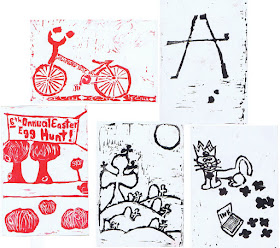Playing cards were probably invented as a result of the invention of wood block printing in China around the ninth century, and were one of the most common early uses of printing in Europe in the fifteenth century. Early in my teaching career in times almost as ancient (well, about two dozen years ago), I decided to have my students corporately create and print a complete deck of cards. There were 56 students in the sixth grade, so each student was in charge of one of the 52 in the deck, plus two jokers, a title card, and a design for the back. Each one designed their card, carved a rubber block, and printed on unlined 4x6 index cards. It turned out to be a great project and a lot of fun, except that each card had to be printed 57 times, and the back had to be printed 3,135 times! I spent a lot of long, late afternoons finishing the printing, since the kids themselves couldn’t get that many done. But in the end, every student received a complete deck of cards.
 As with so many block print projects, both simple graphic designs and complicated detailed designs were very successful. There were a few kids who got their letters or numbers backwards, and a few designs that were just a little too messy to read well, but for the most part the kids’ work was great. Here are a few of my favorites.
As with so many block print projects, both simple graphic designs and complicated detailed designs were very successful. There were a few kids who got their letters or numbers backwards, and a few designs that were just a little too messy to read well, but for the most part the kids’ work was great. Here are a few of my favorites.
Notice that the bicycle treads on the ace of diamonds write “ACE ACE” and that there are six hidden diamond-shaped eggs for the 6 of diamonds. The ace of clubs, in case you can’t see it, is composed of golf clubs, and the clubs for the 10 are charming little graveyard ghosts, plus a tree. The queen of clubs is yet another clever interpretation of the club shape.
With the spades you can see again how creatively different kids interpreted the shape and came up with interesting designs, from the peacock tail of the ace and the spade-spots on the cow (notice that the grass of the cow’s field is composed of 10’s), to the elegant Egyptians with 9 white spades on the chair and 9 black spades in the rest of the design. I love the skritchy lines of the jack. I don’t know what he’s doing up there, but he does look like a bit of a rascal.
The spider and its web seems cute as the 4 of hearts, but there’s a little darkness to the idea of ensnaring hearts, and the king of hearts, with its tattoo aesthetic, also seems not quite to be trusted! On the other hand, making the Tin Woodman the ace of hearts seems especially perfect, and I just find the graphic design of the jack very pleasing.
This was a very ambitious project with sixth graders, and I might have chickened out had I actually been more experienced and realized what I was getting myself into. Nevertheless, I, and I think the whole class, were pretty proud of our accomplishment. I have a new scheme for a group project for my printmaking classes in the next two weeks, but I’ll have to see how the classes go before I decide whether or not to introduce it. If we do it, though, you’ll certainly be among the first to see the results!
[Pictures: Ace of diamonds, rubber block print by Susanne Kelly, 1994;
6 of diamonds, rubber block print by Melissa Cain, 1994;
Ace of clubs, rubber block print by David Thorpe, 1994;
10 of clubs, rubber block print by Margaret Cromwell, 1994;
Queen of clubs, rubber block print by Sarah Morrissey, 1994;
Ace of spades, rubber block print by Nikki Hafezizadeh, 1994;
2 of spades, rubber block print by Matt Murphy, 1994;
10 of spades, rubber block print by Emily O’Brien, 1994;
9 of spades, rubber block print by Emily Hazelwood, 1994;
Jack of spades, rubber block print by Nicole LeFrancois, 1994;
Ace of hearts, rubber block print by Sacia Fowler, 1994;
4 of hearts, rubber block print by Mary Fredrickson, 1994;
Jack of hearts, rubber block print by Molly Smith, 1994;
King of hearts, rubber block print by Chris Kinniburgh, 1994.]



No comments:
Post a Comment
I love to hear from you, but please no spam, ads, hateful language, or other abuse of this community.